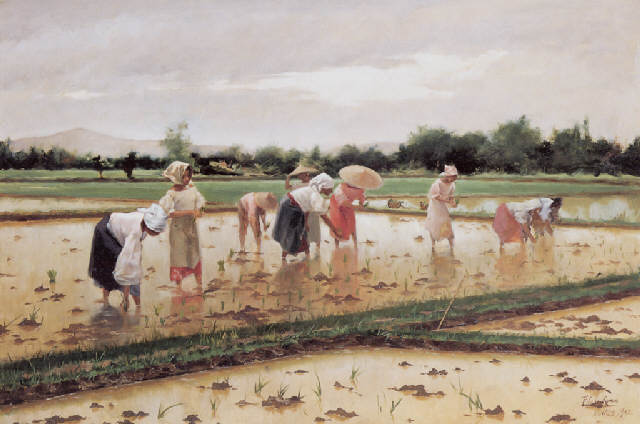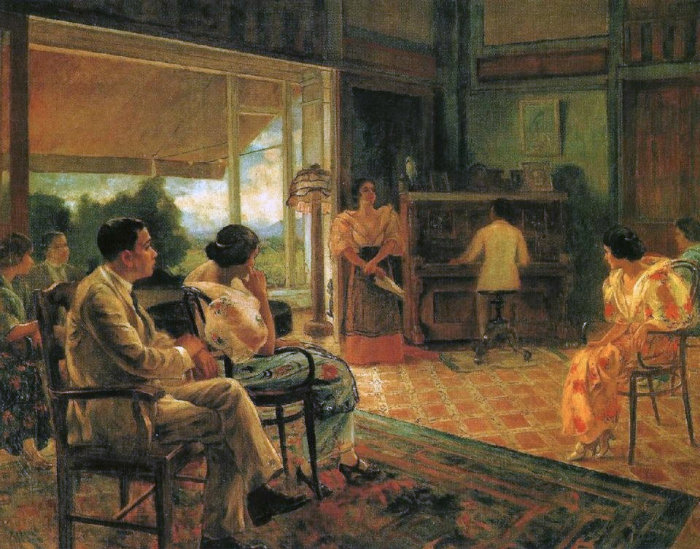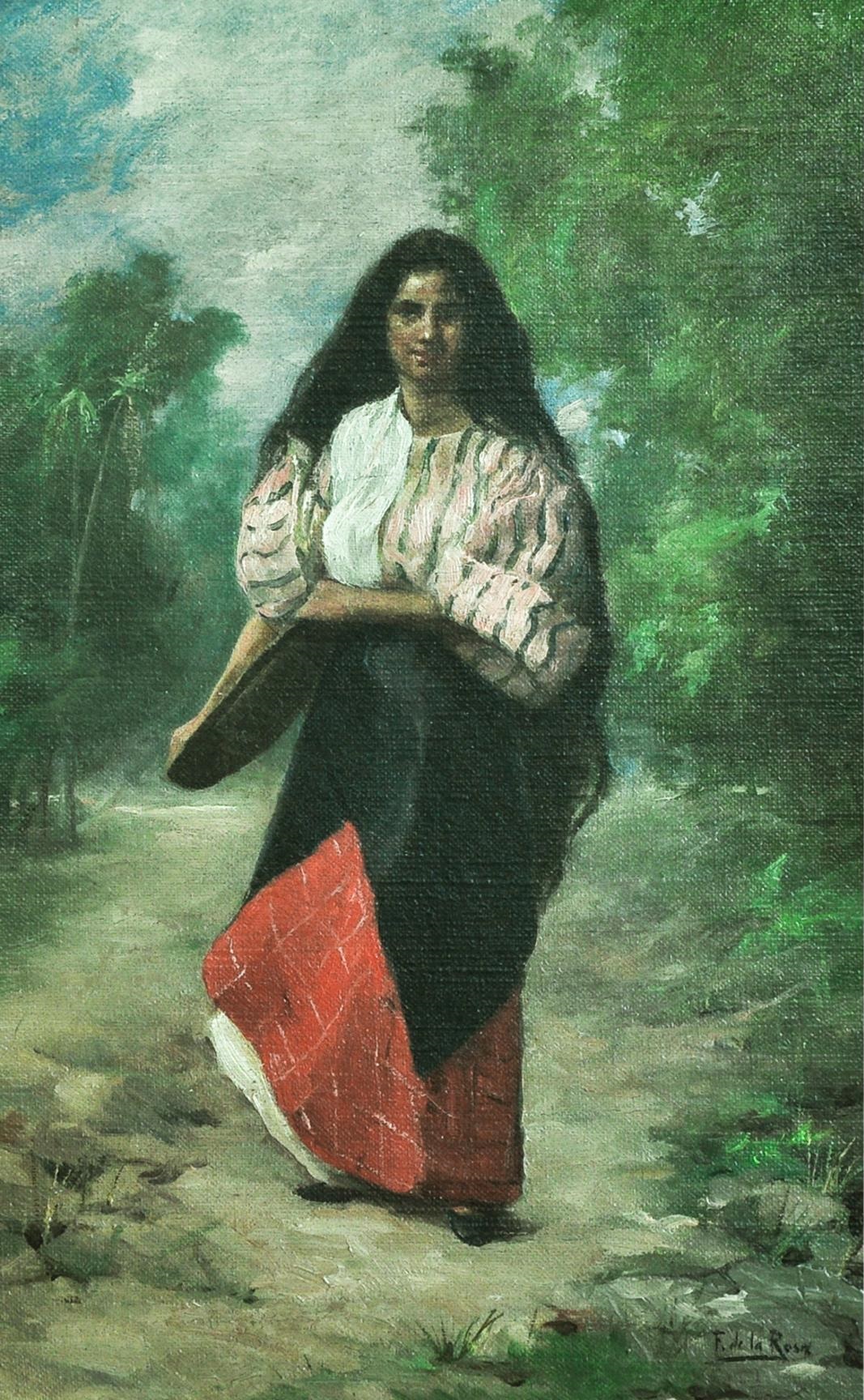Fabián de la Rosa on:
[Wikipedia]
[Google]
[Amazon]
, retrieved on March 18, 2008Hernandez, Eloisa May P., Fabian de la Rosa, The American and Contemporary Traditions in Philippine Visual Arts, NCCA.gov
, retrieved on: April 7, 2008De la Paz, Christiane. Master of Genre: Fabian Cueto dela Rosa (1869-1937), The Arts of the Philippines/Artes de las Filipinas, 2005
retrieved on April 7, 2008Fabián de la Rosa Book Launch and Short Film Premiere, Fabián de la Rosa Book Launch and Short Film Premiere A Night of Discovery, Nostalgia, and Filipino Pride
, Filipiniana.net News and Current Affairs, Filipiniana.net; "Fabián de la Rosa (1869-1937) was, much less that he served as the first Filipino dean of the 100-year-old art institution, or that he was not merely the uncle of celebrated National Artist Fernando Amorsolo, but he made his own mark in the international art scene as gold medal winner in the 1904 World's Fair in St. Louis, Missouri"; "When the documentary was shown, many felt the swelling of Filipino pride on finding out that the 20th century master – though overshadowed by the fame of his predecessors Juan Luna and Felix Resurreccion Hidalgo – was hailed by international critics as one of the greatest Filipino artists of all time...", retrieved on: April 14, 20081901-1940: A Moving Legacy…
, NCCA.gov, "In 1904, the Philippine Commission sent a delegation of 50 Filipino Commissioners to the Louisiana Purchase Expo or World Fair at St. Louis, Missouri USA. Native Filipinos along with an exhibit of Philippine products and replicas of ethnic villages were displayed at the said exposition... The introduction of American culture brought about the sudden modernization in Filipino cities, especially Manila. And with these changes, artists turned their attention anew to what was characteristic of the Philippines. Fabián de la Rosa and Fernando Amorsolo, two genre painters, formed the mainstream of Philippine art in the first quarter of the twentieth century..."; retrieved on: April 14, 2008


''Revue des Arts'', 1931
/ref>

, retrieved on: April 7, 2008
, retrieved on March 19, 2008[http://www.researchsea.com/html/calendar.php/eid/991/cid/5/research/fabian_de_la_rosa__1869-1938__retrospective_exhibition.html Fabian dela Rosa: Retrospective Exhibition, Vargas Museum, University of the Philippines, Researchsea.com, September 2006], retrieved on April 7, 2008
Paintings
at ArtesdelasFilipinas.com
Video Documentary on Fabian de la Rosa Premieres on YouTube, News and Current Affairs, Filipiniana.net, January 17, 2007
{{DEFAULTSORT:De La Rosa, Fabian 1869 births 1937 deaths People from Paco, Manila Filipino portrait painters Académie Julian alumni 19th-century Filipino painters 20th-century Filipino painters
Don
Don, don or DON and variants may refer to:
Places
*County Donegal, Ireland, Chapman code DON
*Don (river), a river in European Russia
*Don River (disambiguation), several other rivers with the name
*Don, Benin, a town in Benin
*Don, Dang, a vill ...
Fabián de la Rosa y Cueto (May 5, 1869 – December 14, 1937) was a Filipino
Filipino may refer to:
* Something from or related to the Philippines
** Filipino language, standardized variety of 'Tagalog', the national language and one of the official languages of the Philippines.
** Filipinos, people who are citizens of th ...
painter. He was the uncle and mentor to the Philippines' national artist in painting, Fernando Amorsolo
Fernando Cueto Amorsolo (born Fernando Amorsolo y Cueto; May 30, 1892 – April 24, 1972) was a portraitist and painter of rural Philippine landscapes. Nicknamed the "Grand Old Man of Philippine Art," he was the first-ever to be recognized as a N ...
, and to his brother Pablo
Pablo is a Spanish form of the name Paul.
People
*Pablo Alborán, Spanish singer
*Pablo Aimar, Argentine footballer
* Pablo Armero, Colombian footballer
* Pablo Bartholomew, Indian photojournalist
* Pablo Brandán, Argentine footballer
* Pablo Br ...
. He is regarded as a "master of genre" in Philippine art. Fabian Cueto de la Rosa, GeringerArt.com (undated), retrieved on March 18, 2008Hernandez, Eloisa May P., Fabian de la Rosa, The American and Contemporary Traditions in Philippine Visual Arts, NCCA.gov
, retrieved on: April 7, 2008De la Paz, Christiane. Master of Genre: Fabian Cueto dela Rosa (1869-1937), The Arts of the Philippines/Artes de las Filipinas, 2005
retrieved on April 7, 2008Fabián de la Rosa Book Launch and Short Film Premiere, Fabián de la Rosa Book Launch and Short Film Premiere A Night of Discovery, Nostalgia, and Filipino Pride
, Filipiniana.net News and Current Affairs, Filipiniana.net; "Fabián de la Rosa (1869-1937) was, much less that he served as the first Filipino dean of the 100-year-old art institution, or that he was not merely the uncle of celebrated National Artist Fernando Amorsolo, but he made his own mark in the international art scene as gold medal winner in the 1904 World's Fair in St. Louis, Missouri"; "When the documentary was shown, many felt the swelling of Filipino pride on finding out that the 20th century master – though overshadowed by the fame of his predecessors Juan Luna and Felix Resurreccion Hidalgo – was hailed by international critics as one of the greatest Filipino artists of all time...", retrieved on: April 14, 20081901-1940: A Moving Legacy…
, NCCA.gov, "In 1904, the Philippine Commission sent a delegation of 50 Filipino Commissioners to the Louisiana Purchase Expo or World Fair at St. Louis, Missouri USA. Native Filipinos along with an exhibit of Philippine products and replicas of ethnic villages were displayed at the said exposition... The introduction of American culture brought about the sudden modernization in Filipino cities, especially Manila. And with these changes, artists turned their attention anew to what was characteristic of the Philippines. Fabián de la Rosa and Fernando Amorsolo, two genre painters, formed the mainstream of Philippine art in the first quarter of the twentieth century..."; retrieved on: April 14, 2008

Early life and education
Fabián de la Rosa was born inPaco, Manila
Paco, formerly known as Dilao, is a district of Manila, Philippines located south of the Pasig River, and San Miguel, west of Santa Ana, southwest of Pandacan, north of Malate, northwest of San Andres Bukid, and east of Ermita. According ...
to husband and wife Marcos de la Rosa and Gorgonia Cueto. Born to a family of artists, he was exposed to art at an early age and learned to draw well before he could write. He was trained to sketch portraits and landscapes by his aunt, Marciana de la Rosa, when he was ten years old. He also apprenticed under his uncle, Simón Flores y de la Rosa, a well-known painter of portraits and church interiors from the nineteenth century. De la Rosa lived most of his life in the Philippines and visited Europe for the first time when he was 39. He married Gorgonia Tolentino on January 13, 1900.
Career


Academic Training
De la Rosa received formal education at the age of 12 when he enrolled at the ''Escuela de Artes y Oficios'' in 1881. Three years into his training de la Rosa's father died, forcing the young painter to drop out of the school in order to help feed his family. It was during this time that he painted his first known masterpiece, ''La Perla de Lucban.'' In 1893, he entered the '' Escuela Superior de Pintura Escultura y Grabado'' at the age of 24 where he received training from Lorenzo Guerrero and Miguel Zaragoza. In 1898, de la Rosa won a contest for a scholarship to Spanish Art Academy of San Fernando in Madrid. However, the outbreak of the Philippine Revolution meant his dream would not materialize. Later under the American regime, the ''Escuela'' would become one of the three founding units of theUniversity of the Philippines
The University of the Philippines (UP; fil, Pamantasan ng Pilipinas Unibersidad ng Pilipinas) is a state university system in the Philippines. It is the country's national university, as mandated by Republic Act No. 9500 (UP Charter of 20 ...
(established in 1908) and renamed the UP School of Fine Arts. In 1908, he traveled to Europe as a ''pensionado'' through a scholarship opportunity given by the ''Germinal Cigar Factory.'' He attended the Académie Julian in Paris, France.(fr''Revue des Arts'', 1931
/ref>
As a professor
After traveling from Europe, he became one of the first instructors at the School of Fine Arts at theUniversity of the Philippines
The University of the Philippines (UP; fil, Pamantasan ng Pilipinas Unibersidad ng Pilipinas) is a state university system in the Philippines. It is the country's national university, as mandated by Republic Act No. 9500 (UP Charter of 20 ...
, where he introduced to his students the decorated form of painting. De la Rosa became the full director of the school from 1927 to 1937.
Exhibition
Together with his wife, de la Rosa went back to Europe in 1928, where he painted in Paris for four months. He also traveled toMunich, Germany
Munich ( ; german: München ; bar, Minga ) is the capital and most populous city of the States of Germany, German state of Bavaria. With a population of 1,558,395 inhabitants as of 31 July 2020, it is the List of cities in Germany by popu ...
, Geneva, Switzerland
Geneva ( ; french: Genève ) frp, Genèva ; german: link=no, Genf ; it, Ginevra ; rm, Genevra is the second-most populous city in Switzerland (after Zürich) and the most populous city of Romandy, the French-speaking part of Switzerland. Situa ...
, and Rome. Upon reaching Madrid
Madrid ( , ) is the capital and most populous city of Spain. The city has almost 3.4 million inhabitants and a Madrid metropolitan area, metropolitan area population of approximately 6.7 million. It is the Largest cities of the Europ ...
, Spain, he held an exhibit of his works at the ''Ateneo de Madrid''.
Reviews
It is believed that de la Rosa was able to paint about 1,000 works. De la Rosa's works were divided by Aurelio S. Alvero into three time periods: those that are academic but are not giving importance to atmosphere and ambience; those that have academic form that gives importance to the environment that could be sensed; and those that play with the use of colors.
Works
*''Women Working in a Rice Field'', 1902 *''Transplanting Rice'', 1904 *''The Death of General Lawton'', 1904 *''Un recuerdo de la Villa Borghese'' (''A Remembrance of the Villa Borghese''), 1909 *''Planting Rice'', 109.2 x 190.6 cm, oil on canvas, 1921, Malacañan Palace Collection *''Los Baños'', watercolor, 56.2 x 66.4 cm, 1922, UP Vargas Museum *''La pintora'' (''Woman Painter'') *''La bordadora'' (''The Embroiderer'') *''Landscape with Dark Trees'', 1927 *''Barcazas en el Rio'' (''Houseboats in a River''), oil on canvas, Private Collection, USA *''Pasay Beach, Manila'', 1927 *''Young Filipina'', oil on canvas, 34.2 x 27.9 cm, 1928, Paulino Que Collection *''Elkundiman
Kundiman is a genre of traditional Filipino love songs. The lyrics of the kundiman are written in Tagalog. The melody is characterized by a smooth, flowing and gentle rhythm with dramatic intervals. Kundiman was the traditional means of sere ...
'' (The Kundiman), 1930
*''Riverview of Sta. Ana'', 48.2 x 64.5 cm, oil on canvas, 1938, UP Vargas Museum Collection
*''Marikina Road'', ca. 1939
*''View of Santa Ana''
*''Marikina Valley'', oil on canvas, 39.3 x 50 cm, undated, UP Vargas Museum Collection
*'' El Kabayo'' 48.2 x 64.5 cm, oil on canvas, 1938, UP Vargas Museum Collection
Awards
Even after his death, de la Rosa was recognized and was given the ''Patnubay ng Sining at Kalinangan'' (Guide of the Arts and Culture) by theCity of Manila
Manila ( , ; fil, Maynila, ), officially the City of Manila ( fil, Lungsod ng Maynila, ), is the capital of the Philippines, and its second-most populous city. It is highly urbanized and, as of 2019, was the world's most densely populated ...
in 1968.
De la Rosa's ''Transplanting Rice'' received the golden award at the International Exposition held in St. Louis, Missouri
St. Louis () is the second-largest city in Missouri, United States. It sits near the confluence of the Mississippi and the Missouri Rivers. In 2020, the city proper had a population of 301,578, while the bi-state metropolitan area, which e ...
in 1904. It is also during this exposition when his ''The Death of General Lawton'' was awarded the bronze prize.
An exposition about the paintings of de la Rosa was held at the Jorge B. Vargas Museum of the University of the Philippines
The University of the Philippines (UP; fil, Pamantasan ng Pilipinas Unibersidad ng Pilipinas) is a state university system in the Philippines. It is the country's national university, as mandated by Republic Act No. 9500 (UP Charter of 20 ...
, in Diliman
Quezon City (, ; fil, Lungsod Quezon ), also known as the City of Quezon and Q.C. (read in Filipino as Kyusi), is the most populous city in the Philippines. According to the 2020 census, it has a population of 2,960,048 people. It was fou ...
, Quezon City
Quezon City (, ; fil, Lungsod Quezon ), also known as the City of Quezon and Q.C. (read in Filipino as Kyusi), is the most populous city in the Philippines. According to the 2020 census, it has a population of 2,960,048 people. It was fou ...
, on January 14, 2007. The presentation was given the title ''"Fabian De la Rosa (1869-1938) Retrospective Exhibition,"'' and was managed by the University of the Philippines with the assistance of the ''Spanish Program for Cultural Cooperation'' and Filipiniana.net, a part of Vibal Publishing House, Inc.Fabian dela Rosa: Retrospective Exhibition, Vargas Museum, University of the Philippines, VargasMuseum.org, 2006, retrieved on: April 7, 2008
, retrieved on March 19, 2008[http://www.researchsea.com/html/calendar.php/eid/991/cid/5/research/fabian_de_la_rosa__1869-1938__retrospective_exhibition.html Fabian dela Rosa: Retrospective Exhibition, Vargas Museum, University of the Philippines, Researchsea.com, September 2006], retrieved on April 7, 2008
See also
*Justiniano Asuncion *José Honorato Lozano *Damián Domingo *Fernando Amorsolo
Fernando Cueto Amorsolo (born Fernando Amorsolo y Cueto; May 30, 1892 – April 24, 1972) was a portraitist and painter of rural Philippine landscapes. Nicknamed the "Grand Old Man of Philippine Art," he was the first-ever to be recognized as a N ...
*Juan Luna
Juan Luna de San Pedro y Novicio Ancheta (, ; October 23, 1857 – December 7, 1899) was a Filipino painter, sculptor and a political activist of the Philippine Revolution during the late 19th century. He became one of the first recogni ...
*Félix Resurrección Hidalgo
Félix Resurrección Hidalgo y Padilla (February 21, 1855 – March 13, 1913) was a Filipino artist. He is acknowledged as one of the greatest Filipino painters of the late 19th century, and is significant in Philippine history for having been a ...
References
External links
*Fabián de la Rosa'Paintings
at ArtesdelasFilipinas.com
Video Documentary on Fabian de la Rosa Premieres on YouTube, News and Current Affairs, Filipiniana.net, January 17, 2007
{{DEFAULTSORT:De La Rosa, Fabian 1869 births 1937 deaths People from Paco, Manila Filipino portrait painters Académie Julian alumni 19th-century Filipino painters 20th-century Filipino painters